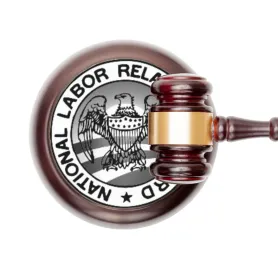The National Labor Relations Board (NLRB) has issued a Notice of Proposed Rulemaking (NPRM) that includes changes to its representation case procedures that potentially may affect both construction employers and building trades unions.
The proposed rule, if approved, would benefit employees by protecting their right to choose. It also would protect construction employers from unwittingly adopting a “permanent” bargaining relationship.
Interested parties must file their comments to the NPRM by October 18, 2019, after which reply comments may be filed until November 1, 2019.
Background
Under Section 9(a) of the National Labor Relations Act (NLRA), an employer’s obligation to bargain with a union generally arises through a union victory in an NLRB-conducted secret-ballot election or by the employer’s voluntary recognition of the union based on a review of union authorization cards signed by a majority of that employer’s employees. Either way, there must be some manifestation of majority support for the union by employees.
Recognition under Section 9(a) carries significant benefits for a labor organization — the employer’s duty to recognize and bargain with the union continues indefinitely. The employer has no unilateral ability to disengage from the bargaining obligation. The employees may seek to remove the union at an appropriate time, usually by petitioning the NLRB to conduct a decertification vote. However, NLRB rules shield newly installed unions by barring decertification during a period to negotiate a contract. Then, if an agreement is reached, that protection is extended up to three more years.
The Section 9(a) rule applies to all employers. However, Section 8(f) of the Act provides employers in the construction industry an additional option. Many employers in the construction industry (but certainly not all) employ a variable number of workers for intermittent periods. Where there is a high degree of workforce fluidity, it may be difficult for a union to establish majority support in a distinct bargaining unit. Also, in some markets, otherwise non-union employers may seek access to union hiring halls as a source of qualified labor. This is why, in 1959, Congress amended the Act to allow construction employers to recognize unions and to adopt collective bargaining agreements (CBAs) without a showing of majority employee support — indeed, without any showing of employee support for the union at all.
Section 8(f) Recognition
Section 8(f) recognition has become a common and expedient practice in the construction industry. While unions benefit from prompt recognition under Section 8(f), they do not have the same protections given to unions under Section 9(a). Unions recognized through Section 8(f) are not immune from decertification petitions filed at any time by employees (or rival unions). Employers are free to terminate their relationship with the union upon the expiration of the CBA, with no further obligation to continue dealing with the union.
Thus, unions are motivated to convert an 8(f) affiliation into a more permanent relationship under 9(a). To accomplish this, under the majority-rule principles of the Act, an 8(f) union would need to provide the employer a current showing of employee majority support and persuade the employer to voluntarily modify the relationship. Failing that, it could seek an NLRB election.
Staunton Fuel & Materials
Through case decisions, the NLRB re-interpreted the requirements of conversion to Section 9(a) recognition, eliminating the requirement of any proof of actual majority support by employees.
In Staunton Fuel & Materials, Inc., 335 NLRB 717 (2001), the Board held the mere statement in a CBA that the employer recognized the union based on a card majority — without any actual showing of evidence — would constitute adequate proof of lawful and binding Section 9(a) recognition, thus creating a bar to decertification petitions and unilateral withdrawal by the employer.
In Staunton Fuel, the Board held that a contract would be sufficient proof where the agreement unequivocally asserts:
-
The union requested recognition as the majority or § 9(a) representative of the unit employees;
-
The employer recognized the union as the majority or § 9(a) bargaining representative; and
-
The employer’s recognition was based on the union’s having shown, or having offered to show, evidence of its majority support.
Not surprisingly, these recognition recitations became common “boilerplate” in construction CBAs. Many construction bargaining relationships are created through one-page pre-hire contracts, project labor agreements, or assent agreements that read in by reference a complete “standard” area contract — which include a Staunton Fuel-style provision. Often, employers sign these abbreviated agreements without receiving or reading the full CBAs. The three-factor recognition scenario described in Staunton Fuel often never takes place. Nonetheless, under Staunton Fuel, the Board accepts the CBA language as fact without investigating whether there actually was demonstrated employee majority support.
Section 8(f) reflected an accommodation to the industry and to unions that might otherwise be unable to organize construction workers. But the rule of Staunton Fuel allowed the Act to be used in a manner that ignored the rights of employees — those rights the NLRA was intended to protect.
Court Decisions on Staunton Fuel
Several court decisions pushed back on Staunton Fuel, most recently and significantly the U.S. Court of Appeals for the D.C. Circuit in Colorado Fire Sprinkler, Inc. v. NLRB, 891 F.3d 1031 (2018). In Colorado Fire Sprinkler, the Court vacated a Board order premising a bargaining relationship solely on Staunton Fuel-style language in a contract executed by the parties. The Court focused on the importance of employee free choice in determining when a 9(a) relationship has been established. It stated:
The raison d’être of the National Labor Relations Act’s protections for union representation is to vindicate the employees’ right to engage in collective activity and to empower employees to freely choose their own labor representatives.
The Court of Appeals continued:
Because the statutory objective is to ensure that only unions chosen by a majority of employees enjoy Section 9(a)’s enhanced protections, the Board must faithfully police the presumption of Section 8(f) status and the strict burden of proof to overcome it. Specifically, the Board must demand clear evidence that the employees—not the union and not the employer—have independently chosen to transition away from a Section 8(f) pre-hire arrangement by affirmatively choosing a union as their Section 9(a) representative.
Staunton Fuel, said the Court, “would reduce the requirement of affirmative employee support to a word game controlled entirely by the union and employer. Which is precisely what the law forbids.”
Adopts Colorado Fire Sprinkler
The Board majority, in issuing the NPRM, adopted the Colorado Fire Sprinkler rationale. The NPRM would mandate that Section 9(a) recognition in the construction industry be based upon a contemporaneous showing of majority employee support. The Board majority also said that employee rights to self-determination by majority rule is so important that Staunton Fuel should not be reversed merely by issuing a new decision, but by promulgating a formal rule. The rulemaking process eliminates the risk of the Staunton Fuel rationale being restored without public notice by an expedient case decision.




 />i
/>i

